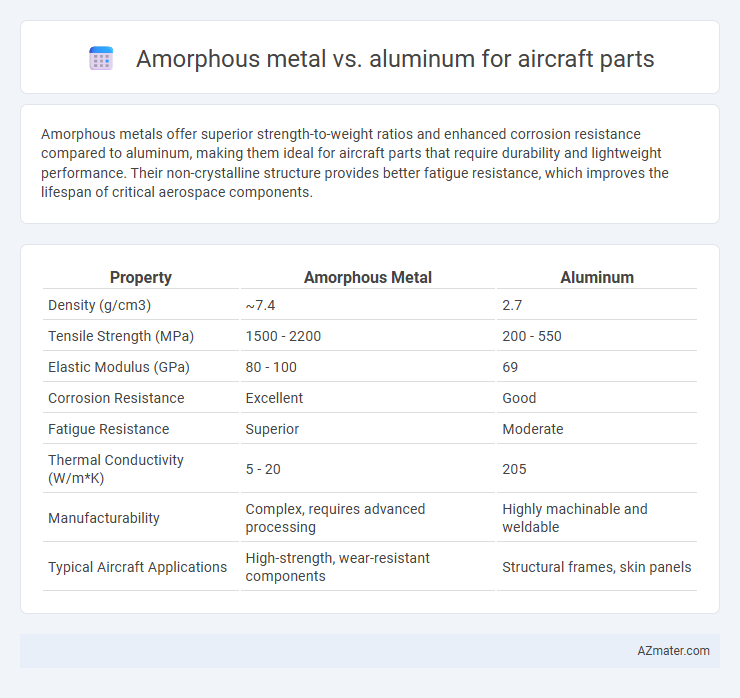Amorphous metals offer superior strength-to-weight ratios and enhanced corrosion resistance compared to aluminum, making them ideal for aircraft parts that require durability and lightweight performance. Their non-crystalline structure provides better fatigue resistance, which improves the lifespan of critical aerospace components.
Table of Comparison
| Property | Amorphous Metal | Aluminum |
|---|---|---|
| Density (g/cm3) | ~7.4 | 2.7 |
| Tensile Strength (MPa) | 1500 - 2200 | 200 - 550 |
| Elastic Modulus (GPa) | 80 - 100 | 69 |
| Corrosion Resistance | Excellent | Good |
| Fatigue Resistance | Superior | Moderate |
| Thermal Conductivity (W/m*K) | 5 - 20 | 205 |
| Manufacturability | Complex, requires advanced processing | Highly machinable and weldable |
| Typical Aircraft Applications | High-strength, wear-resistant components | Structural frames, skin panels |
Introduction: Amorphous Metal and Aluminum in Aerospace
Amorphous metals, also known as metallic glasses, offer superior strength, corrosion resistance, and fatigue performance compared to traditional aluminum alloys commonly used in aerospace. Aluminum remains a staple in aircraft parts due to its lightweight and proven manufacturability, but amorphous metals provide enhanced mechanical properties that can improve aircraft durability and efficiency. The integration of amorphous metals in aerospace components highlights significant advancements in materials engineering aiming to optimize weight reduction and structural performance.
Material Properties Overview
Amorphous metals exhibit superior strength and wear resistance compared to aluminum, with a non-crystalline atomic structure that enhances hardness and corrosion resistance, making them ideal for high-stress aircraft parts. Aluminum alloys, valued for their lightweight and excellent machinability, provide good tensile strength and corrosion resistance but typically have lower hardness and fatigue limits than amorphous metals. The choice between these materials depends on balancing weight reduction, mechanical performance, and durability requirements in aerospace applications.
Mechanical Strength Comparison
Amorphous metals exhibit significantly higher mechanical strength and hardness compared to traditional aluminum alloys used in aircraft parts, offering superior resistance to deformation and fatigue. The amorphous structure eliminates grain boundaries, resulting in enhanced tensile strength and improved wear resistance, critical for high-stress aerospace components. Aluminum alloys, while lightweight and corrosion-resistant, typically demonstrate lower yield strength and stiffness, making amorphous metals a promising alternative for applications requiring exceptional mechanical performance.
Weight and Density Differences
Amorphous metals exhibit a density typically around 7.4 to 7.8 g/cm3, which is slightly lower than aluminum's average density of 2.7 g/cm3, making aluminum significantly lighter for aircraft parts. Despite this weight advantage, amorphous metals offer superior strength-to-weight ratios, allowing for thinner, more durable components that can offset their higher density in some aerospace applications. Aircraft manufacturers must balance aluminum's low density with the enhanced mechanical properties of amorphous metals when optimizing for weight and performance.
Corrosion Resistance in Aircraft Environments
Amorphous metals exhibit superior corrosion resistance compared to aluminum in aircraft environments due to their non-crystalline atomic structure, which eliminates grain boundaries that typically act as corrosion initiation sites. This enhanced resistance extends the lifespan of critical aircraft components exposed to harsh conditions such as salt spray and humidity. Aluminum, while lightweight and widely used, is more susceptible to pitting and galvanic corrosion, necessitating protective coatings for prolonged durability.
Manufacturability and Processing Techniques
Amorphous metals, also known as metallic glasses, offer superior hardness and corrosion resistance compared to aluminum, but their manufacturability is limited by complex rapid cooling requirements and challenges in forming large-scale, intricate aircraft parts. Aluminum alloys benefit from well-established processing techniques such as extrusion, rolling, and machining, enabling cost-effective mass production with high precision and scalability. The choice between amorphous metals and aluminum for aircraft components hinges on balancing the advanced material properties of metallic glasses against the practical advantages of aluminum's versatile and mature manufacturing processes.
Cost Considerations for Aerospace Applications
Amorphous metal offers higher strength-to-weight ratios than aluminum, potentially lowering long-term lifecycle costs despite higher initial material expenses. Aluminum remains cost-effective due to established manufacturing processes, widespread availability, and lower raw material prices. In aerospace applications, balancing the upfront cost of amorphous metal against performance gains and maintenance savings is crucial for optimized budget allocation.
Fatigue Life and Durability Analysis
Amorphous metals exhibit superior fatigue life compared to aluminum due to their disordered atomic structure, which minimizes crack initiation and propagation under cyclic loading. Their enhanced durability is attributed to higher strength-to-weight ratios and exceptional resistance to wear and corrosion, critical factors in aircraft parts subjected to variable stress and harsh environments. Aluminum alloys, while lighter and cost-effective, generally demonstrate lower fatigue endurance, necessitating more frequent inspections and replacements in aerospace applications.
Performance in Extreme Temperatures
Amorphous metals exhibit superior performance in extreme temperatures compared to aluminum, maintaining structural integrity and resistance to thermal fatigue up to temperatures exceeding 600degC. Aluminum alloys typically weaken and lose strength above 200-300degC, limiting their use in high-heat aircraft components. The enhanced thermal stability and wear resistance of amorphous metals make them ideal for critical aircraft parts exposed to intense heat and cyclic thermal stresses.
Future Prospects: Amorphous Metals in Aviation
Amorphous metals exhibit superior strength-to-weight ratios and enhanced corrosion resistance compared to aluminum, presenting promising potential for next-generation aircraft components. Their unique atomic structure enables improved fatigue resistance and increased durability, crucial for aerospace applications demanding long service life and safety. Ongoing research focuses on optimizing manufacturing processes and alloy compositions to fully integrate amorphous metals into aviation, aiming to reduce fuel consumption through weight savings and improve overall aircraft performance.

Infographic: Amorphous metal vs Aluminum for Aircraft part
 azmater.com
azmater.com